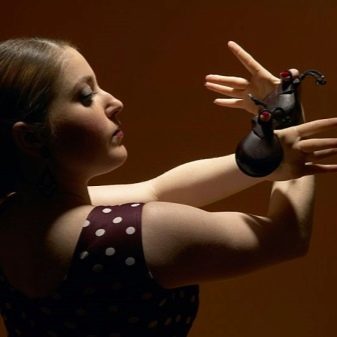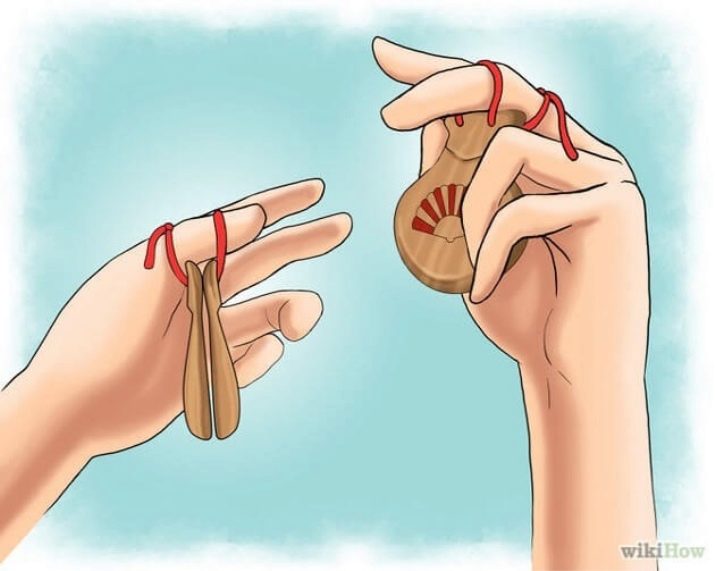What are castanets and where are they used?

Castanets are a popular and irreplaceable attribute of Latin American and Spanish dances. They complement the movements with the necessary rhythm and give the dance a special flavor, give the viewer an unforgettable show. What is an instrument and how to play it, we will consider in this article.


What it is?
Castanets are a musical percussion instrument that emits a rhythmic and beautiful sound when shaken, without a certain pitch. The tool looks very simple and consists of a pair of circular planes concave inward. Holes are drilled at one point. A cord is passed through them to connect the two halves. The cord is tied in a knot that can be adjusted. Fingers are inserted inside the assembly. These halves differ slightly in size and are divided into male and female. The smaller half is female and is called embra, while the male is larger and is called macho.


Initially, the instrument was made of wood, as it was the most readily available material, mainly chestnut. The halves fit comfortably in the hand because they are small (from 2.5 to 5 cm). There are different design options.
- Orchestral bands can be singles or doubles. A special handle is attached to the main plane, it is easier and more comfortable to play them, and the sound is louder.
- Regular, classical, without a handle, used by the dancer herself while moving. Only a trained professional can play on such halves.
- There are also options in which the castanets are installed on a stand, this method is also provided for the convenience of the game.

Currently, you can find this tool not only from ordinary wood, but also from expensive varieties of wood (ebony, rosewood, sandalwood), fiberglass, ivory and even metal.



History
This tool has a very ancient history of emergence. There are various assumptions. Alone historians believe that Columbus brought them to Europe after the discovery of America, others that they were used by the Moors after the conquest of Spain. They accepted them as a gift from the barbarians and could not part with them in the future. Third researchers are sure that castanets were used even in the Roman Empire during the dances of Andalusian dancers.

Due to the fact that their shape in the closed state resembles a chestnut, they were called castanets, since the word “chestnuts” is translated into Russian. Their homeland was the Arab countries of the East, Spain and Latin America. Images with them can be seen on the frescoes of Ancient Greece and Egypt, which testifies to their use long before our days.
In the XII century, the sound of this instrument was widely used not only in folk music, but also in opera, ballet, where it was necessary to give the work a Spanish motive.

In ballet, their sound was used in both group and solo dance. Now their use is not widespread, because it is very difficult to master the technique of the game, moreover, the dancer must come up with a dance pattern himself. And the dance should be in perfect harmony with the sound of the instrument.
In the middle of the 19th century, a center for teaching national dances and playing this instrument was founded in Spain. For this, the most gifted artists were selected, who conquered not only their country, but also the countries of Europe with their skill at dance shows.
La Argentina made a huge contribution to improving the skill of playing the castanets. This dancer is from Spain, who at the beginning of the 20th century toured all over the world.


In 1955, during the performance of the symphony orchestra, the American artist Carola Goya made her debut with castanets, which led to the huge delight of the audience.
Even the belly dance, which was performed in front of the Turkish padishahs, and later in front of Napoleon himself, was accompanied by this instrument.
In the last century in Russia it was difficult to acquire professional and high-quality wooden castanets. Now this problem has been solved, as there is a productive cooperation with Spanish companies for the production and delivery of tools. Jale is the largest Spanish manufacturer. Its products are of guaranteed quality that matches a professional tool. The brand's products can be seen in the countries of Europe, Korea, the USA and Japan.

Application and repertoire
The use of "Spanish halves" is quite diverse. It is impossible to imagine flamenco dancing without them. Castanets are used to give rhythm and tempo to songs; they organically complement the sound of other musical instruments. The sound of castanets can be heard in various musical compositions, the list of which is known among connoisseurs of real art:
- these are operas by J. Bizet, R. Wagner;
- works by P. Tchaikovsky and S. Prokofiev;
- opera "Solomey" by R. Strauss;
- ballet "Don Quixote" by L. Minkus;
- ballet “Lame Demon” by K. Gide;
- Spanish overtures by M. Glinka;
- ballet "Laurencia" by A. Kerin.


The art of mastering playing the castanets was taught to future dancers from childhood. The technique of playing the castanets is peculiar and complex. Firstly, they strongly constrain the dancer's hand movements. Secondly, dancers should always compose new dance compositions themselves. Thirdly, it is necessary, invisibly from the viewer, to combine playing the castanets with dancing, and this is just at first glance.
Therefore, not every dancer, if he is not a Spaniard, manages to be perfect in this art form.

Popular Artists
Despite the fact that the instrument is the main attribute of the Spanish dance accompaniment, which reflects the beating of their hearts, only virtuoso masters can combine playing the instrument and do complex steps. The most famous conquerors of the public of the 20th century are Jose de Udaet and his successor, Jose Luis Landry.
Among the talented performers of the present time, who brilliantly and skillfully represent castanets at concert venues, one can distinguish:
- Lucero Tenu;
- Carmen de Vicente;
- Amparo de Triana;
- Belen Cabanes;
- Teresa Lais;
- Mar Besana.
All of them delight the audience with the sound of the instrument. Thanks to such performances, its historical value and the significance of national traditions are preserved.

How to play?
Before learning how to play this instrument, you can simply tap or clap your hands, the same is done with the instrument. To begin with, you can knock several times, gradually increasing and complicating the tasks. During the game, the hand is in special tension, not only its muscles are strengthened, but also the motor skills of the fingers develop.

For playing the castanets, two genres are used: classical and popular. If you want to master the classic genre, then you need to put the halves on your thumb with the help of the string that ties them.
In your right hand you hold the smaller half, it makes a sound more expressive and higher, it is called hembra. To play with your right hand correctly, you must use your index finger, middle finger, ring finger, and pinky finger.
They, like hammers, gently tap on the surface and hold the female half.

A large, male half called macho is held in the left hand. The hand emphasizes the tempo with individual notes. If the work is performed in a folk genre, then a large instrument with a low sound is used for this. Such halves can be attached to one or all fingers at once using a rope. As you move your hand, the halves move and produce a distinct, loud sound that differs from the normal playing method.
From an ordinary castanet playing, you can achieve about five sounds that sound differently, have a distinctive timbre and volume. Thanks to them, the trained player recreates chic clear sounds and rhythmic patterns.
To rehearse the game well, you need to diligently tap each finger in turn, starting with the smallest and gradually increasing the tempo so that the sound is most distinct.

If you are using your left hand, strike with your middle, ring and little fingers in sync. If this is the right hand, then thanks to it you pick up the pace, and with the left hand you complete the game on one tone.
To achieve a fast rhythm, you need to not be lazy and periodically change the game from one hand to another. Only occasionally can the halves be removed from each other. Every sound is produced distinctly. The instrument must be held correctly in the hand, only then with a careful approach to teaching, in a few lessons, you can learn to play the simplest rhythms.

Lovers and admirers of folk customs believe that the Spanish dance with castanets should be performed in a folk style so as not to lose the native culture of Spain.
After all, Spanish dance is not just a dance, it is a combination of many types of craft: vocals, rhythmic clapping, playing castanets, playing the guitar. The dance involves skillful twists of the hand during a game that opens when clapping and resembles a blossoming flower.

An overview of castanets in the next video.








